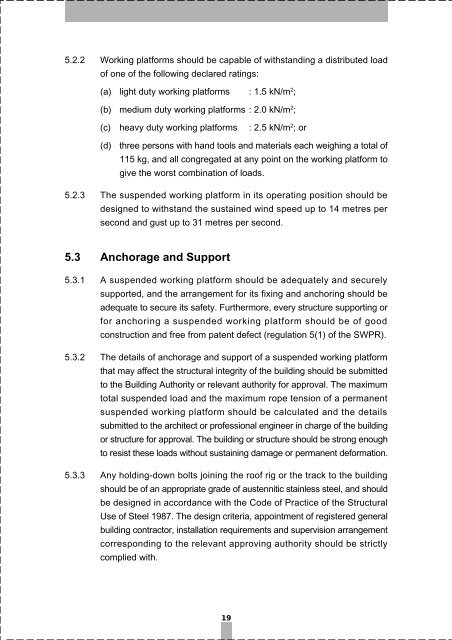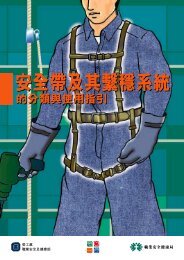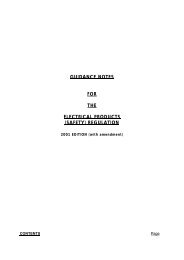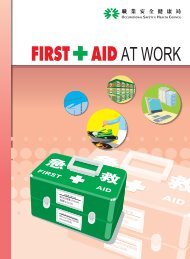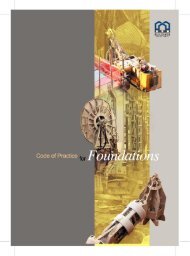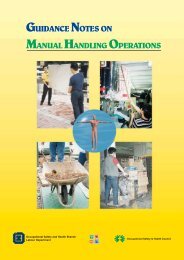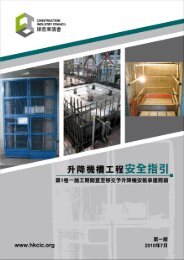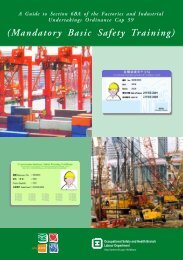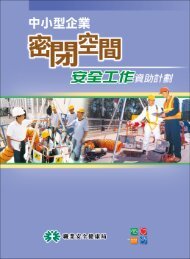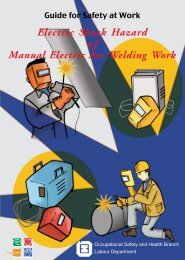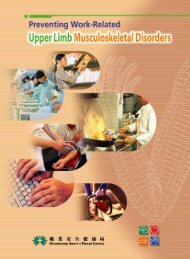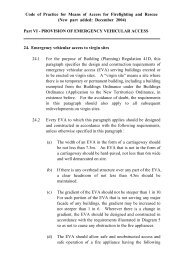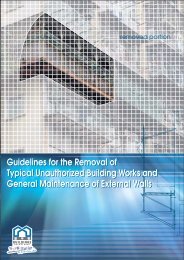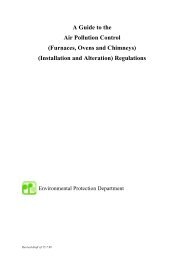Code of Practice for Safe Use and Operation of Suspended Working ...
Code of Practice for Safe Use and Operation of Suspended Working ...
Code of Practice for Safe Use and Operation of Suspended Working ...
- No tags were found...
Create successful ePaper yourself
Turn your PDF publications into a flip-book with our unique Google optimized e-Paper software.
5.2.2 <strong>Working</strong> plat<strong>for</strong>ms should be capable <strong>of</strong> withst<strong>and</strong>ing a distributed load<strong>of</strong> one <strong>of</strong> the following declared ratings:(a) light duty working plat<strong>for</strong>ms : 1.5 kN/m 2 ;(b) medium duty working plat<strong>for</strong>ms : 2.0 kN/m 2 ;(c) heavy duty working plat<strong>for</strong>ms : 2.5 kN/m 2 ; or(d)three persons with h<strong>and</strong> tools <strong>and</strong> materials each weighing a total <strong>of</strong>115 kg, <strong>and</strong> all congregated at any point on the working plat<strong>for</strong>m togive the worst combination <strong>of</strong> loads.5.2.3 The suspended working plat<strong>for</strong>m in its operating position should bedesigned to withst<strong>and</strong> the sustained wind speed up to 14 metres persecond <strong>and</strong> gust up to 31 metres per second.5.3 Anchorage <strong>and</strong> Support5.3.1 A suspended working plat<strong>for</strong>m should be adequately <strong>and</strong> securelysupported, <strong>and</strong> the arrangement <strong>for</strong> its fixing <strong>and</strong> anchoring should beadequate to secure its safety. Furthermore, every structure supporting or<strong>for</strong> anchoring a suspended working plat<strong>for</strong>m should be <strong>of</strong> goodconstruction <strong>and</strong> free from patent defect (regulation 5(1) <strong>of</strong> the SWPR).5.3.2 The details <strong>of</strong> anchorage <strong>and</strong> support <strong>of</strong> a suspended working plat<strong>for</strong>mthat may affect the structural integrity <strong>of</strong> the building should be submittedto the Building Authority or relevant authority <strong>for</strong> approval. The maximumtotal suspended load <strong>and</strong> the maximum rope tension <strong>of</strong> a permanentsuspended working plat<strong>for</strong>m should be calculated <strong>and</strong> the detailssubmitted to the architect or pr<strong>of</strong>essional engineer in charge <strong>of</strong> the buildingor structure <strong>for</strong> approval. The building or structure should be strong enoughto resist these loads without sustaining damage or permanent de<strong>for</strong>mation.5.3.3 Any holding-down bolts joining the ro<strong>of</strong> rig or the track to the buildingshould be <strong>of</strong> an appropriate grade <strong>of</strong> austennitic stainless steel, <strong>and</strong> shouldbe designed in accordance with the <strong>Code</strong> <strong>of</strong> <strong>Practice</strong> <strong>of</strong> the Structural<strong>Use</strong> <strong>of</strong> Steel 1987. The design criteria, appointment <strong>of</strong> registered generalbuilding contractor, installation requirements <strong>and</strong> supervision arrangementcorresponding to the relevant approving authority should be strictlycomplied with.19


